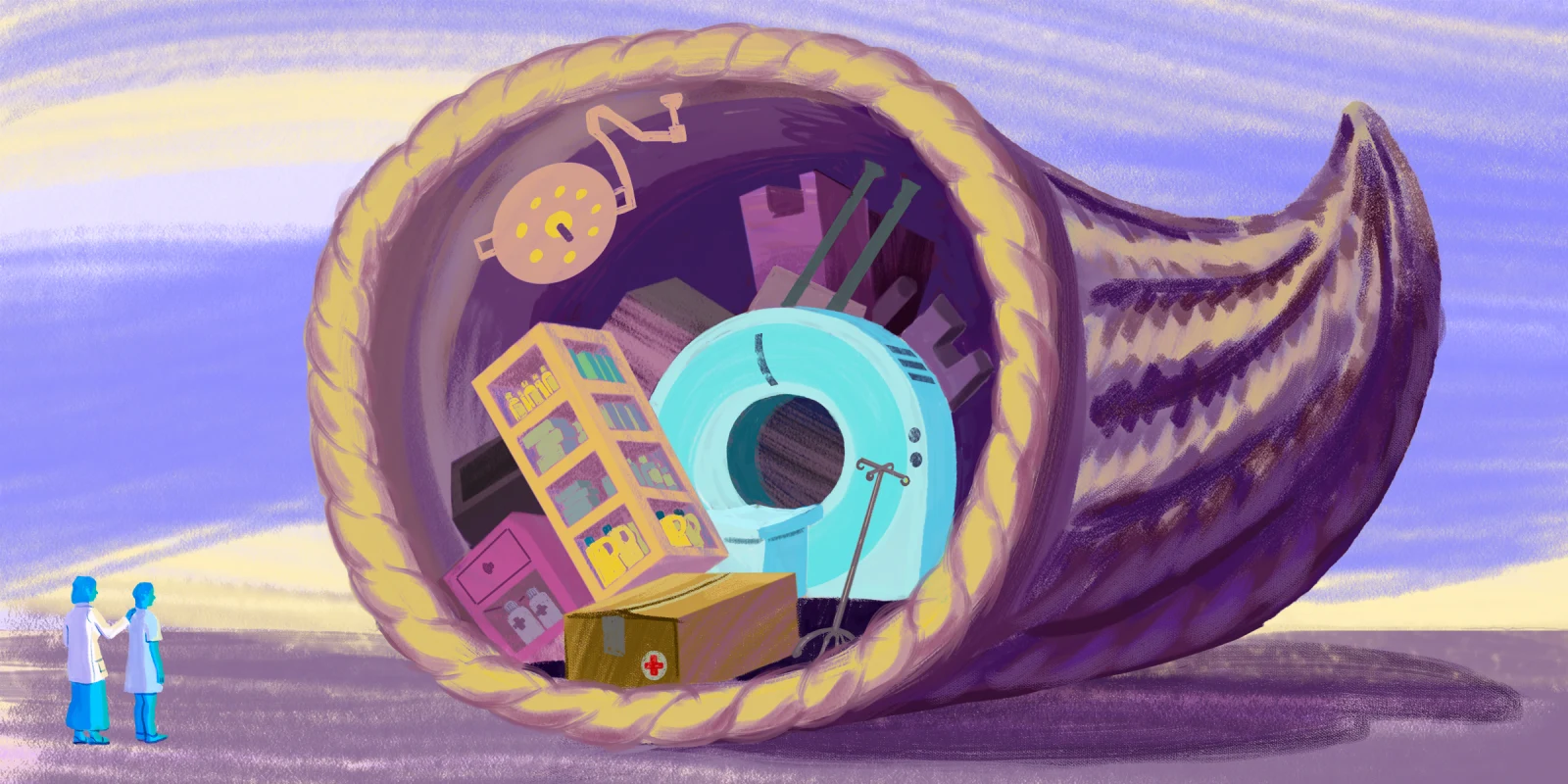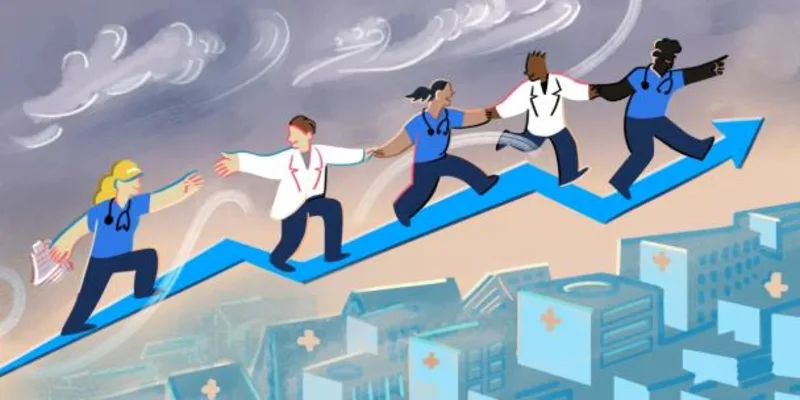It’s 5:30 p.m. The fluorescent lights of an OR hum, but the theatre is empty. Scheduled cases ran late, a shift change occurred, and the intricate ballet of hospital logistics has stumbled. Elsewhere, a primary care physician scrolls through referral options for a patient they worry they will never see again. Still, the wait for a necessary consult stretches for months. At home, a patient rations their medication, caught between refills and a prior authorization denial stuck in digital purgatory. This is American health care: persistent, grinding, normalized scarcity. A paradoxical system where despite vast inputs — hours worked or GDP spent — only a quarter of patients feel their needs are met.
As a medical student, I have witnessed how my residents and attendings navigate this scarcity daily. Our nation’s physicians have become experts in workarounds, prioritizing the urgent over the important, managing the queues. But what if this pervasive scarcity isn’t the fundamental truth of medicine, but the outcome of the rules we’ve written? Outside of medicine, a growing chorus of academics, journalists, and policy wonks are challenging the scarcity mindset that has infected society. Advocating for an “agenda of abundance,” these thinkers argue that rather than debate over dividing the pie, we should focus on creating more of what people need. In sectors from housing to energy they ask: What are the bottlenecks we have created? How can we dismantle them?
Asking these questions of health care, however, reveals a deep cognitive dissonance. We operate at the precipice of human ingenuity — yet carry a scarcity mindset designed to ration and delay. In medicine this mindset can stem from good intentions: quality safeguards, fair access, fiscal prudence, and indeed, the reality of material constraints. However, when scarcity became the default, in practice, policy, and even our formal medical ethics, American health care abdicated its responsibility to patients and forgot its potential. Even in my state, Massachusetts, proud home to “Man’s Greatest Hospital(s),” we have not been immune to the inertia of scarcity. Rectifying this will require a two-fold transformation: first, a fundamental shift in our professional ethics toward abundance, and second, the deliberate implementation of policies that cultivate it.
An Ethos of Abundance
In medicine, our ethical pillars — beneficence, non-maleficence, autonomy, and justice — are often taught by imagining difficult choices in constrained environments, as in the thought experiment “Who gets the last ventilator?” Yet, consider the dialysis crisis of the 1960s, when so few machines existed that hospitals convened infamous ‘God committees’ to decide who lived or died based on perceived “social worth.” The ultimate resolution wasn’t more sophisticated rationing; it was the 1972 Medicare ESRD entitlement, which effectively made dialysis abundant, dissolving that particular ethical horror. The lesson is profound: an abundance ethos compels us to ask why the ventilator is the last one. It shifts our focus from reactive micro-allocation in dire straits to proactive macro-responsibility for system design. If policies constrain care and inflict preventable harm, those policies themselves embody systemic maleficence.
Beyond simply demanding more, an ethos of abundance offers a distinct set of priorities and decision-making heuristics for practical resource questions. When faced with a perceived shortage, an abundance ethos first asks: “Is this scarcity genuine and unavoidable, or is it the product of artificial constraints?” The default action is to seek and remove bottlenecks before accepting rationing. Next, we explicitly valuate “capacity” as “good” by recognizing that even excess capacity is not waste, but a crucial societal asset. This offers a new ethical framework to value over-supply — like investments in surge capabilities that provide resilience and equity and reduce brutal rationing in crises. Finally, this proposed ethos explicitly considers the harm of inaction/delay, recognizing that the benefits of every policy/administrative task/decision panel must be weighed against the iatrogenic harms imposed on clinicians and patients. In an abundance ethos, burdens are no longer inevitable “costs of doing business,” but rather ethically negative outcomes of a poorly designed or constrained system.
From Over-Constriction to Over-Supply
I must admit, I am not a seasoned policy expert. My days are spent in clinical rotations and in textbooks, not navigating the labyrinth of the Hill. And my biomedical engineering and AI research background may lend an idealistic bias to my argument, one that favors innovation over rationing. Yet, perhaps this perspective allows for fresh questions and common-sense approaches. What follows are not definitive answers, but actionable policy blueprints for achieving an abundant health care future.
The most fundamental act of engineering abundance is to allow care to be built where it’s needed. Key word: allow. Today, in 35 states — including the aforementioned Massachusetts — expanding a hospital or opening a new facility first requires a state Certificate of Need (CON). CON laws were first established in the 1960s, and aimed to prevent overbuilding of expensive facilities, theoretically controlling costs and ensuring coordinated planning. In practice, CON regulations often act as chokepoints, empowering incumbents to veto and block potential competitors. Reviews show health care planning via CON fails to contain costs, and instead correlates with higher prices and reduced access. Florida’s experience in particular is telling: after ending its hospital CON requirement in 2019, 65 new hospitals were planned within three years, a roughly 20% increase in the state’s total capacity. This isn’t about unchecked proliferation; in fact, it makes sense to couple CON repeal with strengthened quality licensure. It is, however, about letting supply meet demand.
Beyond increasing the quantity of hospitals, health care will benefit by unleashing our human capital. Our system throttles physician supply in two critical ways: erecting unnecessary practice barriers for qualified doctors, and artificially limiting new physician training. Despite the recognized benefits of telehealth, distinct state board requirements (such as MGL c. 112) limit the ability of a physician in good standing in one state to practice in another. Physicians looking to move must undergo a lengthy, often redundant, licensing process — a system designed before robust national standards for medical education and practitioner databases. Instead, we must allow for universal, streamlined recognition of out-of-state licenses. We did it during COVID-19, when emergency waivers temporarily allowed out-of-state clinicians to help via telemedicine. We should adopt it permanently, immediately expanding our clinician pool, shortening those agonizing waits for specialist consults, and improving care access for our most vulnerable patients.
Equally critical is addressing the artificial cap on physician training. Since 1997, Congress has largely frozen Medicare funding for residency slots at 1996 levels out of fear of an “over-supply” of physicians. The consequence? In 2022, over 3,300 U.S. medical school graduates could not find a residency position, contributing to physician shortages today. This is not a failure of talent, but a failure of policy. My state of Massachusetts, as a leader in medical education, should advocate fiercely for federal uncapping of residency slots. Furthermore, the state should incentivize and finance new residency positions, especially in underserved areas, with commitments to retain graduates. Training more doctors is a direct investment in future abundance.
Then there’s the daily administrative sludges that consume clinical capacity. Chief among these are prior authorizations — insurer-mandated approval before physicians can provide certain medications, tests, or procedures. The stated goal is utilization management: to prevent unnecessary or overly expensive care. However, prior auths have metastasized into a bureaucratic arms race between hospitals and insurers. It is the epitome of scarcity thinking, a presumption that care must be withheld unless proven absolutely necessary. Physicians nationally report losing an average of 14 hours weekly to prior auth paperwork, costing practices around $75,000 per doctor annually. We can help reverse this. Seven states have passed a “Gold Card” law, where if a doctor’s requests are routinely approved, they earn exemption from prior auth for those services. Massachusetts, under MGL C. 1760, should follow suit, as Gold Cards show promising early results and warrant experimentation.
Perhaps the most transformative step toward enduring health care abundance, however, lies not in deregulation, but in fundamentally reimagining how we finance systemic resilience. Our current health care financing system is inherently market driven: largely reliant on fee-for-service payments and capital investment. As such, it can quickly direct resources to valuable care, but often struggles to fund capacity that isn’t immediately profitable. The COVID-19 PPE shortages were a costly lesson in the harm of a system that operates so rigidly within supply and demand. We might glean insights from China, whose industrial policy, for all its warranted criticisms, has achieved immense capacity in strategic sectors. A core mechanism involves state-influenced finance in the form of underpriced or risk-socialized loans. Such loans enable the construction of fixed capital far exceeding what private incentives would dictate. This creates what appears as “overcapacity” by conventional markets but translates into societal option value: the option to rapidly scale production and response. The innovation is in the financing structure: modified repayment terms (often income-driven or amortized against use/social benefit) for bond-funded projects effectively convert fixed capital costs to variable ones for the operator, making it economically viable to build and maintain capacity not maximally profitable short-term. Such a mechanism actually fosters competition in markets by lowering entry barriers for essential services, rather than allowing collapse into Market-distorting Grandiose Blocs that are fragile in times of crises. Instead, what if Massachusetts pioneered state-backed, publicly issued financial instruments, overseen by an independent board of physicians, financial experts, and public health specialists? Such “health care capacity bonds” could fund critical infrastructure to over-supply PPE, as well as diagnostic labs, education, and training, and could even allow for new care delivery models like shared diagnostic hubs.
None of these proposals are silver bullets. Steps such as banning surprise “facility fees,” enacting medical device right-to-repair laws, and reconsidering international graduate training are all equally vital. Rather, what matters most is an interconnected strategy centered on an abundance mentality toward affordable, accessible care.
Overcoming Inertia
The surgeon facing an empty OR, the physician navigating referral deserts, the patient rationing medication — their experiences are not inevitable. They are the symptoms of a system too often designed, by commission or omission, for scarcity. An abundance agenda directly confronts the zero-sum thinking that shackles both policy and ethos, charting a future where clinicians and patients thrive.
Abundance in medicine, like any significant societal advance, will undoubtedly face headwinds. Entrenched parties, comfortable within the familiar architecture of scarcity, will raise objections. Yet, for those of us at the bedside who face the daily confrontation with the human cost of scarcity, the imperative for change is visceral. We must end the dispiriting ritual of apology: “I’m sorry, your insurance didn’t authorize this MRI.” “I’m sorry, the specialist appointment is months out.” “I’m sorry, I wish I could do more.” We are trained to heal and to fix, so we are weaponized to shield a system that obstructs. We internalize these moments as inevitable parts of the job, but collapse under the cumulative weight of harrowing injustice and flawed policy. Our calling demands more than quiet endurance; it demands that we become architects of the systemic reforms our patients deserve.
The blueprints outlined above are more than policy proposals — they are an invitation. A summons for the fresh perspectives and rigorous, systems-oriented thinking necessary to meet this critical moment. For this is a challenge that requires not just incremental adjustments, but the vision to see beyond scarcity and the courage to engineer our way to abundance. It is a challenge worthy of our boldest efforts.
What policies would you implement to ensure the future of health care is one of abundance, not scarcity? Share in the comments!
Aditya Jain is a medical student at Harvard Medical School. He also is a researcher at the Broad on the applications of artificial intelligence in medicine. When he's not busy with school, he enjoys playing guitar, reading sci-fi, and hiking. He tweets @adityajain_42. Aditya was a 2023–2024 Doximity Op-Med Fellow, and continues as a 2024–2025 Doximity Op-Med Fellow.
Illustration by Jennifer Bogartz






